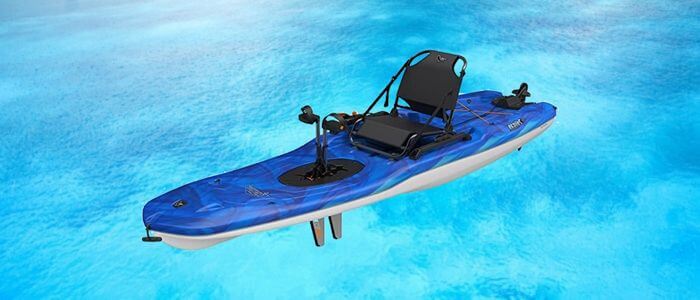
As a kayaker, you’re likely curious about how much do kayaks weigh. Not only does the weight of your kayak affect its performance on the water, but it’s also important to consider when transporting and storing your boat.
The weight of a kayak can vary depending on the materials it is made from, its size, and other factors. However, on average, most kayaks weigh between 20 and 60 pounds. Some ultralight kayaks can weigh as little as 20 pounds, while heavier models may weigh up to 100 pounds.
So in this comprehensive guide, we’ll break down the weight of different types of kayaks so that you can completely understand the concept and choose the best one according to your needs.
This is a question that plagues many people who are interested in getting into the sport of kayaking. The simple answer is that kayaks can weigh anywhere from 20 to 100 pounds, depending on the material they are made from, the size of the kayak, and the features included.
For instance, a kayak made from fiberglass will be on the heavier end of the spectrum, while a kayak made from inflatable materials will be lighter.
The size of the kayak also plays a role in its weight, with larger kayaks generally weighing more than smaller ones.
Finally, paddles, seats, and storage hatches can add to a kayak’s overall weight. So when wondering how much kayaks weigh, remember that there is no definitive answer – it all depends on the individual kayak.
So, let’s get to know the weights of different kayaks.
There are many different types of kayaks, and each type has its weight capacity. The weight capacity is based on the design of the kayak and the material it’s made of. For example, some kayaks are designed for speed and maneuverability, while others are meant for fishing or camping trips.
So let’s get to know some of these types of kayaks and their weight capacity.

Inflatable kayaks are the lightest on the market, weighing less than 25 pounds. They’re great for beginners and are easy to inflate and deflate. Some inflatable kayaks can be folded into a backpack or even fit into a suitcase when deflated.
That is why they are considered the lightest kayaks on the market. All inflatable kayaks have an air chamber you can inflate with a pump. The more air in the chamber, the more rigid your kayak will be—and therefore heavier.

Hard shell kayaks are the heaviest type available, weighing between 45 and 70 pounds. They’re made of fiberglass or carbon fiber and are more durable than inflatable or folding kayaks.
Handling and transporting them is a little difficult compared to inflatable kayaks. So, a hard-shell kayak is not suitable for you if you are looking for a kayak that is easy to transport and doesn’t weigh much.

The weight of recreational kayaks can also vary depending on the material they are made of. For example, if they are made of hard shell plastic, they will weigh between 50 to 70 pounds.
On the other hand, if they are inflatable kayaks, they can weigh between 20 to 30 pounds depending on their size and other factors.
So, recreational kayaks can weigh between 20 to 70 pounds, depending on their size and the material.

Fishing kayaks are usually made of hard-shell plastic, which makes them heavy. The weight of a fishing kayak can vary between 50 to 100 pounds, depending on the size and other factors.
So if you are looking for a kayak that can be your fishing partner, then keep in mind that they might be heavier than you might think.

Pedal kayaks are usually made of hard-shell plastic, which makes them heavy. The weight of a pedal kayak can vary between 50 to 100 pounds depending on its size and the pedal motor installed in it.
These kayaks weigh more because there is a pedal motor in them. The kayak’s weight is also affected by its size, which means that larger pedal kayaks will be heavier than smaller ones. So if you are looking for an all-around kayak that can be used for fishing or commuting and to carry your gear when needed, then keep in mind that they might be heavier than you think.

As you may know, tandem kayaks are built for two people. The weight of a tandem kayak can vary between 60 to 80 pounds, depending on its size and the material it is made of.
If you are looking for a kayak that you can share with your partner or friend, remember that it might be heavier than you think.
So these were some of the kayaks available in the market and their weight. As you can see, the kayak’s weight varies depending on its type, size, and other factors; let’s get in-depth into it and understand the factors that can affect a kayak’s weight.
As said above, many factors can affect a kayak’s weight; the following are some important ones.
The length of a kayak can vary from 10 feet to 18 feet. The weight of the kayak will also increase with its length. For example, a 10-foot kayak will weigh less than a 14-foot kayak.
This is because longer kayaks have more hull material, which adds to their weight. So if you are looking for a kayak that is easy to transport, then go for a shorter one.
The width of the kayak can also affect its weight to some extent. Wider kayaks will weigh more than narrower ones because they have more hull material.
However, the difference in weight will not be as significant as the difference in length. So if you are looking for an easy transport kayak, go for a narrower one.
The material of the kayak is one of the most important factors that can affect its weight. As you might know, kayaks are made of different materials like plastic, fiberglass, and carbon fiber.
Out of these three, plastic kayaks are the heaviest because they have more dense construction and heavy material. On the other hand, carbon fiber kayaks are the lightest because they are made of less dense materials and are naturally lightweight materials. So if you are looking for an easy transport kayak, go for one made of carbon fiber.
The number of seats in a kayak can also affect its weight. A tandem kayak will weigh more than a single-seater kayak because it has two seats and more hull material.
Besides, the difference in weight will be as significant as the difference in length or width. So if you are looking for an easy transport kayak, go for a single-seater. But if you still want a lightweight tandem kayak, you can choose an inflatable tandem kayak, which will weigh hardly above 25 pounds.
The features of the kayak can also affect its weight. For example, a pedal-driven kayak will weigh more than a paddle kayak because it has a pedal motor. So if you are looking for an easy transport kayak, go for one without too many features.
Now that we have seen some important factors that can affect a kayak’s weight let’s see how these factors can be used to choose a kayak according to your needs.
You need to consider many factors while choosing a kayak, like its length, width, material, number of seats, and features. But the most important factor is its weight because it can affect the transport of the kayak.
Here are some tips to help you choose the best kayak according to your needs and weight.
The first step in choosing a kayak is to consider the kayaking you’ll be doing. Are you interested in fishing? Touring? Whitewater kayaking? Each type of kayak is designed for a specific purpose, so it’s important to choose one that will suit your needs.
Kayaks can range in price from a few hundred dollars to several thousand, so it’s important to consider your budget when purchasing. If you’re just getting started in kayaking, you may want to opt for a less expensive model. However, if you’re more experienced, you may want to invest in a higher-quality kayak.
Another important consideration is the size and weight of the kayak. Kayaks can range from 8 to 18 feet and weigh anywhere from 20 to 100 pounds. It’s important to choose a kayak that’s the right size for you, as a too-large or too-small kayak can be difficult to handle.
Kayaks are typically made from either plastic or fiberglass. Plastic kayaks are less expensive but also less durable than fiberglass kayaks. Fiberglass kayaks are more expensive but offer better performance and are more durable.
Once you’ve decided on the perfect kayak, you need to consider how you’ll transport it and store it when you’re not using it.
If you have a large vehicle, such as an SUV or a van, transporting a larger kayak shouldn’t be a problem. However, if you have a smaller car, you may need to invest in a roof rack or trailer to transport your kayak. Additionally, you need to consider where you’ll store your kayak when it’s not in use. If you have limited space, such as in an apartment, you may want to opt for a smaller kayak that can be easily stored inside.
A 10 ft kayak can weigh anywhere from 20 to 100 pounds, depending on the material, length, width, and features. For example, an inflatable kayak will weigh less than a hard-shell kayak. A tandem kayak will weigh more than a single-seater kayak because it has two seats and more hull material.
So there is no definitive answer to this question because the weight of a 10 ft kayak can vary depending on the factors mentioned above.
Most kayaks weigh between 20 and 60 pounds, depending on the materials they’re made from and their length. Some kayaks are even lighter, weighing as little as 20 pounds.
That’s good news for anyone who wants to take their kayak out on the water, but it’s important to remember that heavier kayaks are often more stable than lighter ones. If you’re concerned about your kayak tipping over, choose a model that’s on the heavier side. You’ll be glad you did when you’re out on the waves.
On average, a sit-on-top kayak will weigh between 45 and 70 pounds. The kayak’s weight will depend on the materials it is made from, as well as its size and features. For example, a kayak made from fiberglass will be lighter than one made from polyethylene. A kayak with built-in storage compartments will also be heavier than a basic model.
Sit-in kayaks usually weigh between 30 and 40 pounds. Some kayaks are made with lighter materials, such as carbon fiber, which can make them even lighter. While a kayak’s weight may not seem like much, it can be difficult to maneuver a heavier kayak in and out of the water. For this reason, many kayakers prefer sit-in kayaks on the lighter side. In addition, lighter kayaks are often easier to transport and store.
For some people, yes. For others, no. It all depends on your strength and endurance. A 50-pound kayak is not too heavy for someone fit and strong, but it might be too heavy for someone not used to lifting heavy objects.
So this was all about how much kayaks weigh and the factors that affect a kayak’s weight. We hope you found this article helpful.

Hey there kayak lovers! I’m Jay Schwartz, the author here at Kayak Guidance! You know water sports – you know me! My life is all about it. Kayaking, Paddleboarding, Fishing, Snorkeling and so much more. I love to share my passion and knowledge with all of you.

Hey there kayak lovers! I’m Jay Schwartz, the author here at Kayak Guidance! You know water sports – you know me! My life is all about it. Kayaking, Paddleboarding, Fishing, Snorkeling and so much more. I love to share my passion and knowledge with all of you.

Welcome to KayakGuidance.com! If you’re looking to have some fun outdoor water adventures, then you have come to the right place. We help our readers find the best kayaks and water related equipment to help you have the best time of your life whenever you are engaging in water activities.
This site is a participant in the Amazon services LLC associates program, an affiliate advertising program designed to provide a means for sites to earn advertising fees by advertising and linking to Amazon.com.